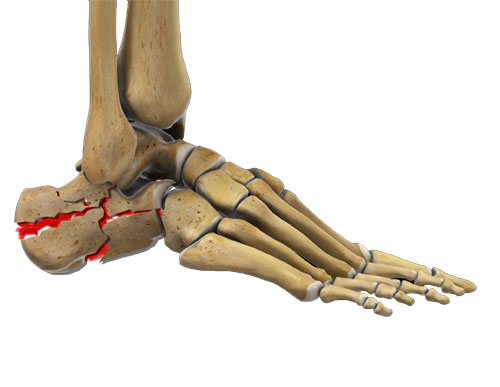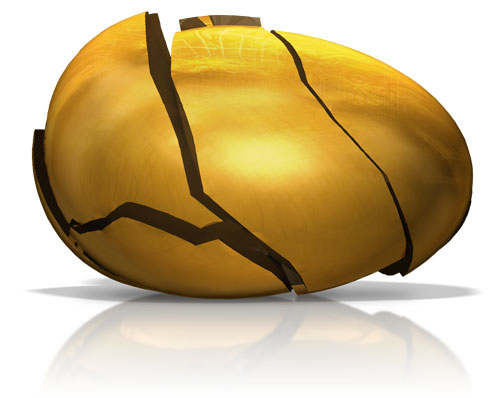Can a Stress Fracture Heal Without a Boot
 Rearfoot fractures of either the heel bone (calcaneus) typically occur after a high impact/velocity injury, such as a fall from height or motor vehicle accident. Due to the force of the injury, the harm is oft all-encompassing and oft requires surgery. These injuries are as well closely associated with the development of post-traumatic arthritis of the subtalar joint (rearfoot).
Rearfoot fractures of either the heel bone (calcaneus) typically occur after a high impact/velocity injury, such as a fall from height or motor vehicle accident. Due to the force of the injury, the harm is oft all-encompassing and oft requires surgery. These injuries are as well closely associated with the development of post-traumatic arthritis of the subtalar joint (rearfoot).
Causes of a Calcaneal Fracture
A calcaneal fracture occurs when an excessive force crushes the heel bone against the talus (the everyman bone of the ankle). The joint between the calcaneus and the talus is known every bit the subtalar articulation, and it is an essential biomechanical component of flexing, continuing, and walking and couples with the ankle joint for dynamic motion. This joint is oft involved in these types of facture which tin atomic number 82 to long term issues with the articulation such equally chronic pain, stiffness and the development of arthritis.
 Treating a calcaneal fracture tin can be extremely tricky, because the fracture is rarely a clean break like y'all might come across in a cleaved shin or arm. Retrieve of the calcaneus equally an egg… with in intact shell it is difficult to break when y'all clasp it in the palm of your hand, however, if there is whatsoever defect or fissure in the surface, whatever aberrant force per unit area to the vanquish cause information technology to crumble as the center is soft and sponge-like. When the calcaneus fractures, the hard outer layer can break into multiple irregular fragments and fold in on itself, just like an egg with a broken shell.
Treating a calcaneal fracture tin can be extremely tricky, because the fracture is rarely a clean break like y'all might come across in a cleaved shin or arm. Retrieve of the calcaneus equally an egg… with in intact shell it is difficult to break when y'all clasp it in the palm of your hand, however, if there is whatsoever defect or fissure in the surface, whatever aberrant force per unit area to the vanquish cause information technology to crumble as the center is soft and sponge-like. When the calcaneus fractures, the hard outer layer can break into multiple irregular fragments and fold in on itself, just like an egg with a broken shell.
Types of Calcaneal Fractures
In that location are several types of fracture patterns that can occur with trauma to the heel os. Some have more simple patterns that do not involve the joint and usually heal without any long term issues while others are more complex with fragment displacement and extend into one of multiple joints and are very challenging to become to heal properly, often requiring surgical intervention to optimize healing.
- Intra-articular fractures. These involve damage to the cartilage betwixt the joints, and are considered the most serious type of heel fracture. These have a high correlation with the eventual development of post traumatic arthritis of the involved articulation (s)
- Avulsion fractures. A fragment of bone is avulsed away from the calcaneus from the pulling from the Achilles tendon or another ligament.
- Multiple fracture fragments. This is too known as a crushed heel injury and is more mutual with higher impact injuries such as a fall from tiptop or automotive accident.
- Stress fractures. While most calcaneal fractures are acquired by a trauma, a calcaneal stress fracture can event from overuse or repetitive trauma (like high book running or jumping).
Symptoms of a Calcaneal Fracture
- Precipitous, severe hurting
- Extensive swelling and bruising in the heel region
- Inability to conduct weight
- A full general pain in the heel that gradually worsens could be a sign of a stress fracture. This will typically on hurt during action and gets better with rest.
Diagnosing Calcaneal Fractures
 If you accept recently experienced a trauma and are experiencing symptoms of a calcaneal fracture, visit your foot and talocrural joint specialist. You doctor will evaluate your foot for swelling and other signs of a fracture or joint impairment. Ten-ray imaging can be helpful in making a diagnosis. Your doctor may also order a CT browse to get a ameliorate thought of the pattern of the fracture, to make up one's mind whether surgery is needed.
If you accept recently experienced a trauma and are experiencing symptoms of a calcaneal fracture, visit your foot and talocrural joint specialist. You doctor will evaluate your foot for swelling and other signs of a fracture or joint impairment. Ten-ray imaging can be helpful in making a diagnosis. Your doctor may also order a CT browse to get a ameliorate thought of the pattern of the fracture, to make up one's mind whether surgery is needed.
Depending on the crusade of your injury, your foot and ankle specialist may as well examine you for an ankle or mid-pes injury, or refer you to another specialist to check for injuries beyond the foot. About 10% of patients with calcaneal fractures besides suffer a back injury called a Lumbar spinal burst fracture. This occurs when a vertebra in the lower-mid back is crushed. Please let you lot medico know if you are also experiencing whatsoever back pain.
Calcaneal Fracture Treatment
Heel bone fractures are notoriously difficult to care for, and commonly require prolonged healing times. Your foot and ankle specialist will assess your injury and determine whether to treat the fracture surgically or not-surgically.
Conservative Handling
Conservative treatment is most appropriate for uncomplicated, non-displaced fracture patterns, especially if they practice not involve the joint. A conservative, not-invasive treatment regimen may also be recommended for patients who are not skilful candidates for surgery. Smokers, elderly patients, and patients with diabetes or vascular affliction may exist at higher take a chance for surgical complication, such as an infection or blood loss.
As astringent as calcaneal fractures tin be, studies take shown that not-surgical treatment can exist very nearly as effective as surgical treatment in the right individuals. Typically, not-surgical handling involves:
- Non-weight begetting status for upwards to 10-12 weeks
- Immobilization in a cast, fracture boot or splint for 8-10 weeks
- Elevation of the foot. When resting, prop your foot up on stools or pillows to proceed information technology above your heart.
- Icing. Use malleable freezer gel packs to the anterior ankle. Change every ii-3 hours to help with swelling
- Compression. Wrap your heel in a compression sock or ace bandage.
- Pain medication. Your doc may prescribe you hurting medication or y'all can take over-the-counter NSAIDs, such equally Ibuprofen and Naproxen. Please annotation that narcotics in our practice are extremely restricted and are Not a good long term solution.
- Physical therapy exercises. Afterward 2 weeks, do drawing a figure-viii with the toes to increase your range of movement in the ankle.
Surgical Handling
- Open Surgical Approach: Surgical correction of a calcaneal fracture takes an extremely skilled surgeon, and is inherently risky. Your surgeon will reconstruct the heel bone to something close to its original shape. Because each fracture is unlike, each surgical procedure is highly individualized.
Typically, surgery cannot begin until the swelling has gone downwards, about x-14 days post-obit the trauma. Operating on an excessively swollen pes may lead to healing problems and information technology tin can increase the take chances for infection.
The surgery is generally performed through an open incision on the outer side of the heel. The surgeon and then carefully repositions the fragments and fixes them into identify with anatomically designed screws and plates.
- Percutaneous Approach: This is a minimally-invasive surgical technique that can exist performed on some less complex fractures (less than x%). The surgeon makes a small incision and pierces the pieces of fractured bone with surgical wire. The surgeon tin can then manipulate the pieces into identify. In one case the fragment position is optimized, then a plate can be slid under the peel and fixated to the bone with a few screws placed through minute incisions forth the periphery of the plate or with multiple screws placed strategically around the fracture without a plate.
Complications of Calcaneal Fracture Surgery
Surgical correction of a fractured heel bone is a risky procedure. Mutual complications may include:
- Infection. Unfortunately, these tin occur. In mild cases, this may be treated with oral antibiotics. In more severe cases, the unabridged surgical may become compromised and require a removal of hardware and any infected tissue or os. Osteomylelitis is a severe deep-wound infection that affects the bone, and the calcaneus is especially vulnerable following this type of injury. If this occurs, this may require multiple surgeries in society to resolve the infection, long term use of Iv antibiotics, and in some extreme cases can atomic number 82 to limb loss if the infection becomes a threat to your wellness.
- Would healing problems. Because circulation to the heel'south soft tissues is relatively weak, the surgical site may not heal properly and may require additional wound care and/or skin grafting.
- Subtalar arthritis. This is a chronic pain condition which ordinarily affects patients with healed calcaneal fractures. If this occurs, at some point yous may need to undergo an additional procedure to fuse the afflicted joints which near commonly the subtalar joint.
- Nerve damage. You may experience permanent numbness at the surgical site. In some cases, the sural nerve (which runs through in incision site) may become entrapped in scar tissue and can become quite painful.
- Not-wedlock: Sometimes the bone simply doesn't heel. If this is the case, the use of a bone growth stimulator (not-invasive) may be beneficial. In more astringent cases, this may crave additional surgery to assist the bone resume normal healing.
 Recovery from Calcaneal Fracture Surgery
Recovery from Calcaneal Fracture Surgery
Post-obit surgery, your foot and ankle specialist will probable immobilize your pes in a splint to allow the bone and joints time to heal. You should follow the at-dwelling house treatments recommended for not-surgical patients, including rest, ice, elevation, and compression.
Y'all should avert bearing weight on the foot for 10-12 weeks until information technology is sufficiently healed. This is often adamant by serial ten-rays performed in the office during your follow-up visits. Once y'all are allowed to comport weight on the foot, Dr. Perler commonly sends you for physical therapy who volition help yous become back to total weight bearing and out of the boot over the following calendar month. Also, many patients will benefit from either custom or over the counter arch supports.
Source: https://www.adamperler.com/services/foot-and-ankle-trauma/41-conditions/50-heel-bone-fractures-calcaneal-fractures.html
Post a Comment for "Can a Stress Fracture Heal Without a Boot"